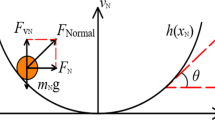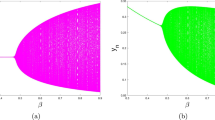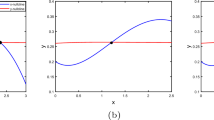Abstract
In this paper, we consider a modified Leslie-type prey–generalist predator system with piecewise–smooth Holling type I functional response. Considering the reproduction rate of the prey population higher than that of the predator, the model becomes a slow–fast system that mathematically leads to a singular perturbation problem. To analyse the stability of the boundary equilibrium on the switching boundary, we use a generalized Jacobian that enables us to investigate how the eigenvalues jump at the boundary point. We investigate the slow–fast system by employing geometric singular perturbation theory and blow-up technique that reveal a wide range of interesting complicated dynamical phenomena. We have studied existence of saddle-node bifurcation, Bogdanov–Takens bifurcation, bistability, singular Hopf bifurcation, canard orbits, multiple relaxation oscillations, saddle-node bifurcation of limit cycle and boundary equilibrium bifurcations. Numerical simulations are carried out to substantiate the analytical results.














Similar content being viewed by others
Data availability
Data sharing is not applicable to this article as no datasets were generated or analysed during the current study.
Change history
09 May 2022
A Correction to this paper has been published: https://doi.org/10.1007/s11071-022-07502-7
References
Ai, S., Sadhu, S.: The entry-exit theorem and relaxation oscillations in slow-fast planar systems. J. Diff. Eq. 268(11), 7220–7249 (2020)
Arima, N., Okazaki, H., Nakano, H.: A generation mechanism of canards in a piecewise linear system. IEICE Trans. Fundament. Electron. Commun. Comput. Sci. 80(3), 447–453 (1997)
Atabaigi, A., Barati, A.: Relaxation oscillations and canard explosion in a predator-prey system of Holling and Leslie types. Nonlinear Anal. Real World Appl. 36, 139–153 (2017)
Baer, S.M., Erneux, T.: Singular Hopf bifurcation to relaxation oscillations. SIAM J. Appl. Math. 46(5), 721–739 (1986)
Buzzi, C.A., de Carvalho, T., Teixeira, M.A.: On 3-parameter families of piecewise smooth vector fields in the plane. SIAM J. Appl. Dyn. Syst. 11(4), 1402–1424 (2012)
Clarke, F.H., Ledyaev, Y.S., Stern, R.J., Wolenski, P.R.: Nonsmooth Analysis and Control Theory, vol. 178. Springer (2008)
De Maesschalck, P., Dumortier, F.: Bifurcations of multiple relaxation oscillations in polynomial Liénard equations. Proceed. Am. Math. Soc. 139(6), 2073–2085 (2011)
Dumortier, F.: Techniques in the theory of local bifurcations: blow-up, normal forms, nilpotent bifurcations, singular perturbations. In: Bifurcations and Periodic Orbits of Vector Fields, 19–73. Springer (1993)
Dumortier, F., Roussarie, R.: Geometric singular perturbation theory beyond normal hyperbolicity. In: Multiple-Time-Scale Dynamical Systems, 29–63. Springer (2001)
Dumortier, F., Roussarie, R.: Multiple canard cycles in generalized liénard equations. J. Diff. Eq. 174(1), 1–29 (2001)
Dumortier, F., Roussarie, R., Roussarie, R.H.: Canard Cycles and Center Manifolds, vol. 577. American Mathematical Soc (1996)
Fenichel, N.: Asymptotic stability with rate conditions. Indiana Univ. Math. J. 23(12), 1109–1137 (1974)
Fenichel, N.: Asymptotic stability with rate conditions, II. Indiana Univ. Math. J. 26(1), 81–93 (1977)
Fenichel, N.: Geometric singular perturbation theory for ordinary differential equations. J. Differ. Eq. 31(1), 53–98 (1979)
Fenichel, N., Moser, J.: Persistence and smoothness of invariant manifolds for flows. Indiana Univ. Math. J. 21(3), 193–226 (1971)
FitzHugh, R.: Mathematical models of threshold phenomena in the nerve membrane. Bull. Math. Biophys. 17(4), 257–278 (1955)
Han, X., Bi, Q.: Slow passage through canard explosion and mixed-mode oscillations in the forced Van der Pol’s equation. Nonlinear Dyn. 68(1–2), 275–283 (2012)
Hsu, T.H.: Number and stability of relaxation oscillations for predator-prey systems with small death rates. SIAM J. Appl. Dyn. Syst. 18(1), 33–67 (2019)
Hsu, T.H., Ruan, S.: Relaxation oscillations and the entry-exit function in multi-dimensional slow-fast systems. SIAM J. Math. Anal. 53(4), 3717–3758 (2021)
Jones, C.K.: Geometric singular perturbation theory. In: Dynamical Systems, 44–118. Springer (1995)
Krupa, M., Szmolyan, P.: Extending geometric singular perturbation theory to nonhyperbolic points–fold and canard points in two dimensions. SIAM J. Math. Anal. 33(2), 286–314 (2001)
Krupa, M., Szmolyan, P.: Extending slow manifolds near transcritical and pitchfork singularities. Nonlinearity 14(6), 1473 (2001)
Krupa, M., Szmolyan, P.: Relaxation oscillation and canard explosion. J. Differ. Eq. 174(2), 312–368 (2001)
Kuehn, C.: Multiple Time Scale Dynamics, vol. 191. Springer (2015)
Perko, L.: Differential Equations and Dynamical Systems. Springer, New York (1991)
Li, S., Wang, X., Li, X., Wu, K.: Relaxation oscillations for Leslie-type predator–prey model with Holling type I response functional function. Appl. Math. Lett. 107328 (2021)
Liu, W., Xiao, D., Yi, Y.: Relaxation oscillations in a class of predator-prey systems. J. Differ. Eq. 188(1), 306–331 (2003)
Ludwig, D., Jones, D.D., Holling, C.S.: Qualitative analysis of insect outbreak systems: the spruce budworm and forest. J. Anim. Ecol. 315–332 (1978)
McDonald, R.A., Webbon, C., Harris, S.: The diet of stoats (Mustela erminea) and weasels (Mustela nivalis) in great britain. J. Zool. 252(3), 363–371 (2000)
Pokrovskii, A., Rachinskii, D., Sobolev, V., Zhezherun, A.: Topological degree in analysis of canard-type trajectories in 3-D systems. Appl. Anal. 90(7), 1123–1139 (2011)
Van der Pol, B.: On relaxation-oscillations. Lond. Edinburgh Dublin Philosoph. Magaz. J. Sci. 2(11), 978–992 (1926)
Prohens, R., Teruel, A., Vich, C.: Slow-fast n-dimensional piecewise linear differential systems. J. Differ. Eq. 260(2), 1865–1892 (2016)
Roberts, A.: Canard explosion and relaxation oscillation in planar, piecewise-smooth, continuous systems. SIAM J. Appl. Dyn. Syst. 15(1), 609–624 (2016)
Roberts, A., Gendinning, P.: Canard-like phenomena in piecewise-smooth Van der Pol systems, Chaos: An Interdisciplinary. J. Nonlinear Sci. 24(2), 023138 (2014)
Rotstein, H.G., Coombes, S., Gheorghe, A.M.: Canard-like explosion of limit cycles in two-dimensional piecewise-linear models of Fitzhugh-Nagumo type. SIAM J. Appl. Dyn. Syst. 11(1), 135–180 (2012)
Saha, T., Pal, P.J., Banerjee, M.: Relaxation oscillation and canard explosion in a slow-fast predator-prey model with Beddington-DeAngelis functional response. Nonlinear Dyn. 103(1), 1195–1217 (2021)
Scheffer, M.: Ecology of Shallow Lakes, vol. 22. Springer (2004)
Seo, G., DeAngelis, D.L.: A predator-prey model with a Holling type I functional response including a predator mutual interference. J. Nonlinear Sci. 21(6), 811–833 (2011)
Seo, G., Kot, M.: A comparison of two predator-prey models with Holling’s type I functional response. Math. Biosci. 212(2), 161–179 (2008)
Simpson, D.J.W.: Bifurcations in Piecewise-Smooth Continuous Systems, vol. 70. World Scientific (2010)
Stenseth, N.C., Falck, W., Bjørnstad, O.N., Krebs, C.J.: Population regulation in snowshoe hare and Canadian lynx: asymmetric food web configurations between hare and lynx. Proceed. National Acad. Sci. 94(10), 5147–5152 (1997)
Szmolyan, P., Wechselberger, M.: Relaxation oscillations in \(\mathbb{R}^3\). J. Differ. Eq. 200(1), 69–104 (2004)
Turchin, P.: Complex Population Dynamics: a Theoretical/Empirical Synthesis, vol. 35. Princeton University Press (2003)
Turchin, P., Hanski, I.: An empirically based model for latitudinal gradient in vole population dynamics. Am. Natur. 149(5), 842–874 (1997)
Vakakis, A.F.: Relaxation oscillations, subharmonic orbits and chaos in the dynamics of a linear lattice with a local essentially nonlinear attachment. Nonlinear Dyn. 61(3), 443–463 (2010)
Verhulst, F.: Singular perturbation methods for slow-fast dynamics. Nonlinear Dyn. 50(4), 747–753 (2007)
Wang, Z., Zhang, Z., Bi, Q.: Relaxation oscillations in a nonsmooth oscillator with slow-varying external excitation. Int. J. Bifurc. Chaos 29(07), 1930019 (2019)
Xia, Y., Zhang, Z., Bi, Q.: Relaxation oscillations and the mechanism in a periodically excited vector field with pitchfork-Hopf bifurcation. Nonlinear Dyn. 101(1), 37–51 (2020)
Yaru, L., Shenquan, L.: Canard-induced mixed-mode oscillations and bifurcation analysis in a reduced 3D pyramidal cell model. Nonlinear Dyn. 101(1), 531–567 (2020)
Acknowledgements
The first author acknowledges the financial support from the Department of Science and Technology (DST), Govt. of India, under the scheme “Fund for Improvement of S&T Infrastructure (FIST)” [File No. SR/FST/MS-I/2019/41].
Author information
Authors and Affiliations
Ethics declarations
Conflict of interest
The authors declare that they have no conflict of interest.
Additional information
Publisher's Note
Springer Nature remains neutral with regard to jurisdictional claims in published maps and institutional affiliations.
Appendix
Appendix
Rights and permissions
About this article
Cite this article
Saha, T., Pal, P.J. & Banerjee, M. Slow–fast analysis of a modified Leslie–Gower model with Holling type I functional response. Nonlinear Dyn 108, 4531–4555 (2022). https://doi.org/10.1007/s11071-022-07370-1
Received:
Accepted:
Published:
Issue Date:
DOI: https://doi.org/10.1007/s11071-022-07370-1




